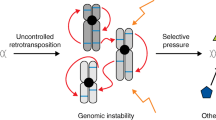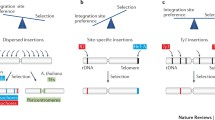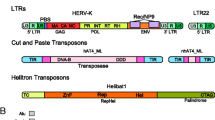Abstract
The eukaryotic transposon Mos1 is a class-II transposable element that moves using a “cut-and-paste” mechanism in which the transposase is the only protein factor required. The formation of the excision complex is well documented, but the integration step has so far received less investigation. Like all mariner-like elements, Mos1 was thought to integrate into a TA dinucleotide without displaying any other target selection preferences. We set out to synthesize what is currently known about Mos1 insertion sites, and to define the characteristics of Mos1 insertion sequences in vitro and in vivo. Statistical analysis can be used to identify the TA dinucleotides that are non-randomly targeted for transposon integration. In vitro, no specific feature determining target choice other than the requirement for a TA dinucleotide has been identified. In vivo, data were obtained from two previously reported integration hotspots: the bacterial cat gene and the Caenorhabditis elegans rDNA locus. Analysis of these insertion sites revealed a preference for TA dinucleotides that are included in TATA or TA × TA motifs, or located within AT-rich regions. Analysis of the physical properties of sequences obtained in vitro and in vivo do not help to explain Mos1 integration preferences, suggesting that other characteristics must be involved in Mos1 target choice.




Similar content being viewed by others
References
Berg DE, Johnsrud L, McDivitt L, Ramabhadran R, Hirschel BJ (1982) Inverted repeats of Tn5 are transposable elements. Proc Natl Acad Sci USA 79:2632–2635
Bessereau JL, Wright A, Williams DC, Schuske K, Davis MW, Jorgensen EM (2001) Mobilization of a Drosophila transposon in the Caenorhabditis elegans germ line. Nature 413:70–74
Bryan G, Garza D, Hartl D (1990) Insertion and excision of the transposable element mariner in Drosophila. Genetics 125:103–114
Coates CJ, Turney CL, Frommer O’BrochtaDA, Atkinson PW (1997) Interplasmid transposition of the mariner transposable element in non-drosophilid insects. Mol Genet Genomics 253:728–733
Crénès G, Ivo D, Hérisson J, Dion S, Renault S, Bigot Y, Petit A (2009) The bacterial Tn9 chloramphenicol resistance gene: an attractive DNA segment for Mos1 mariner insertions. Mol Genet Genomics 281:315–328
Davies CJ, Hutchison CAIII (1995) Insertion site specificity of the transposon Tn3. Nucl Acids Res 23:507–514
Gabrielian A, Simoncsits A, Pongor S (1996) Distribution of bending propensity in DNA sequences. FEBS Lett 393:124–130
Gabrielian A, Vlahovicek K, Pongor S (1997) Distribution of sequence-dependent curvature in genomic DNA sequences. FEBS Lett 406:69–74
Granger L, Martin E, Segalat L (2004) Mos as a tool for genome-wide insertional mutagenesis in Caenorhabditis elegans: results of a pilot study. Nucl Acids Res 32:e117
Guimond N, Bideshi DK, Pinkerton AC, Atkinson PW, O’Brochta DA (2003) Patterns of Hermes transposition in Drosophila melanogaster. Mol Genet Genomics 268:779–790
Guyetant S, Giraud M, L’Hours L et al (2005) Cluster of re-configurable nodes for scanning large genomic banks. Parallel Comput 31:73–96
Halling SM, Kleckner N (1982) A symmetrical six-base-pair target site sequence determines Tn10 insertion specificity. Cell 28:155–163
Ikeda R, Kokubu C, Yusa K, Keng VW, Horie K, Takeda J (2007) Sleeping beauty transposase has an affinity for heterochromatin conformation. Mol Cell Biol 27:1665–1676
Julian AM (2003) Use of bioinformatics to investigate and analyze transposable element insertions in the genomes of Caenorhabditis elegans and Drosophila melanogaster, and into the target plasmid pGDV1. Thesis University of Texas
Lampe DJ, Churchill MEA, Robertson HM (1996) A purified mariner transposase is sufficient to mediate transposition in vitro. EMBO J 15:5470–5479
Liang Q, Kong J, Stalker J, Bradley A (2009) Chromosomal mobilization and reintegration of Sleeping Beauty and PiggyBac transposons. Genesis 47:404–408
Liao GC, Rehm EJ, Rubin GM (2000) Insertion site preferences of the P transposable element in Drosophila melanogaster. Proc Natl Acad Sci USA 97:3347–3351
Linheiro RS, Bergman CM (2008) 2008 Testing the palindromic target site model for DNA transposon insertion using the Drosophila melanogaster P-element. Nucleic Acids Res 36:6199–6208
Liu D, Bischerour J, Siddique A, Buisine N, Bigot Y, Chalmers R (2007) The human SETMAR protein preserves most of the activities of the ancestral Hsmar1 transposase. Mol Cell Biol 27:1125–1132
Lohe AR, Hartl DL (1996) Germline transformation of Drosophila virilis with the transposable element mariner. Genetics 143:365–374
Manna D, Wang X, Higgins NP (2001) Mu and IS1 Transpositions Exhibit Strong Orientation Bias at the Escherichia coli bgl Locus. J Bact 183:3328–3335
Maragathavally KJ, Kaminski JM, Coates CJ (2006) Chimeric Mos1 and piggyBac transposases result in site-directed integration. FASEB J 20:1880–1882
Peters JE, Craig NL (2001) Tn7 recognizes transposition target structures associated with DNA replication using the DNA-binding protein TnsE. Gene Dev 15:737–747
Pribil PA, Haniford DB (2000) Substrate recognition and induced DNA deformation by transposase at the target-capture stage of Tn10 transposition. J Mol Biol 303:145–159
Pribil PA, Haniford DB (2003) Target DNA bending is an important specificity determinant in target site selection in Tn10 transposition. J Mol Biol 330:247–259
Robert VJ, Bessereau JL (2009) Manipulating the Caenorhabditis elegans genome using mariner transposons. Genetica. doi:10.1007/s10709-009-9362-2
Saville KJ, Warren WD, Atkinson PW, O’Brochta DA (1999) Integration specificity of the hobo element of Drosophila melanogaster is dependent on sequences flanking the integration site. Genetica 1999(105):133–147
Shevchenko Y, Bouffard GG, Butterfield YS, Blakesley RW, Hartley JL, Young AC, Marra MA, Jones SJ, Touchman JW, Green ED (2002) Systematic sequencing of cDNA clones using the transposon Tn5. Nucleic Acids Res 30:2469–2477
Shilova VY, Garbuz DG, Myasyankina EN, Chen B, Evgen’ev MB, Feder ME, Zatsepina OG (2006) Remarkable site specificity of local transposition into the Hsp70 promoter of Drosophila melanogaster. Genetics 173:809–820
Shimizu K, Kamba M, Sonobe H, Kanda T, Klinakis AG, Savakis C, Tamura T (2000) Extrachromosomal transposition of the transposable element Minos occurs in embryos of the silkworm Bombyx mori. Insect Mol Biol 9:277–281
Taillebourg E, Dura JM (1999) A novel mechanism for P element homing in Drosophila. Proc Natl Acad Sci USA 96:6856–6861
Tosi LR, Beverley SM (2000) cis and trans factors affecting Mos1 mariner evolution and transposition in vitro, and its potential for functional genomics. Nucleic Acids Res 28:784–790
Tower J, Karpen GH, Craig N, Spradling AC (1993) Preferential transposition of Drosophila P elements to nearby chromosomal sites. Genetics 133:347–359
van Luenen HG, Plasterk RH (1994) Target site choice of the related transposable elements Tc1 and Tc3 of Caenorhabditis elegans. Nucleic Acids Res 22:262–269
Vigdal TJ, Kaufman CD, Izsvak Z, Voytas DF, Ivics Z (2002) Common physical properties of DNA affecting target site selection of Sleeping Beauty and other Tc1/mariner transposable elements. J Mol Biol 323:441–452
Vlahovicek K, Kajan L, Pongor S (2003) DNA analysis servers: plot.it, bend.it, model.it and IS. Nucleic Acids Res 31:3686–3687
Vos JC, De Baere I, Plasterk RH (1996) Transposase is the only nematode protein required for in vitro transposition of Tc1. Gene Dev 10:755–761
Wang W, Lin C, Lu D, Ning Z, Cox T, Melvin D, Wang X, Bradley A, Liu P (2008) Chromosomal transposition of PiggyBac in mouse embryonic stem cells. Proc Natl Acad Sci USA 105:9290–9295
Whitfield CR, Wardle SJ, Haniford DB (2008) The global bacterial regulator H-NS promotes transpososome formation and transposition in the Tn5 system. Nucleic Acids Res 1–13
Acknowledgements
This work was supported by the University of François Rabelais of Tours, and funded by grants from the European Commission (Project SyntheGeneDelivery, No. 018716), the C.N.R.S., the French Ministère de l’Education Nationale, de la Recherche et de la Technologie (MENRT), the Association Française contre la Myopathie, the Groupement de Recherche CNRS 2157. G. Crénès holds a doctoral fellowship from the European Commission. We would like to thank Dr L. Segalat providing the sequences of insertion in C. elegans rDNA. The English text has been revised by Dr M. Ghosh.
Author information
Authors and Affiliations
Corresponding author
Electronic Supplementary Material
Rights and permissions
About this article
Cite this article
Crénès, G., Moundras, C., Demattei, MV. et al. Target site selection by the mariner-like element, Mos1 . Genetica 138, 509–517 (2010). https://doi.org/10.1007/s10709-009-9387-6
Received:
Accepted:
Published:
Issue Date:
DOI: https://doi.org/10.1007/s10709-009-9387-6




